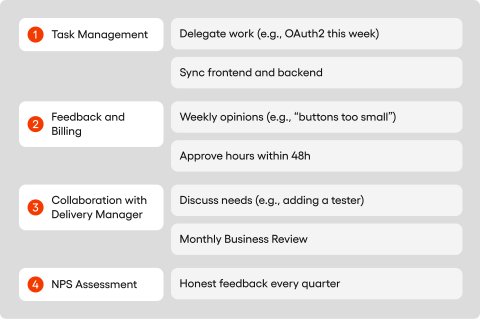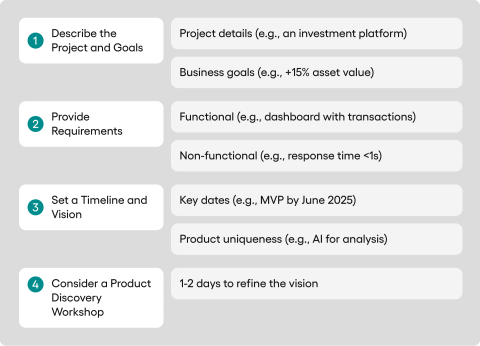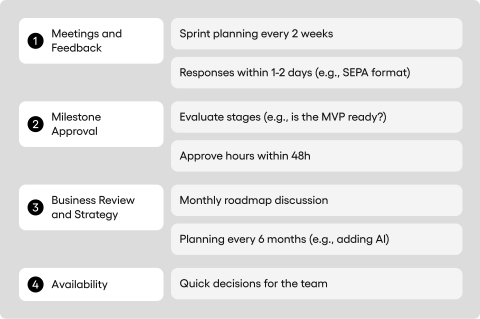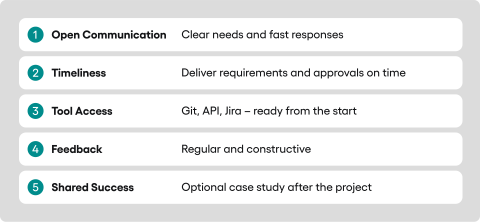What level of involvement ensures project success when working with IT companies?


This article aims to outline what collaboration with a software house typically involves so you understand the level of engagement needed from your side to achieve project success together. Should we even talk about ‘expectations’ when collaborating with a client? We believe so, but we see them as essential elements for effectively reaching your goals rather than one-sided demands.
With years of experience and hundreds of collaborations behind us, we’ve observed a strong correlation between project success and the client’s attitude and active participation. It’s important to stress that gathering this information and your involvement primarily benefits you – it allows us to better understand your needs and deliver a solution that brings real business value.
In this blog post, we’ll explore two main collaboration models: Team Extension and end-to-end project delivery (A to Z). For each, we’ll discuss the key aspects of your engagement at two stages: before work begins and during the project. Finally, we’ll present some universal principles that underpin any successful tech partnership.
Table of contents
Model team extension: preparing for collaboration
In the Team Extension model, our specialists become an integral part of your IT team, supporting them in specific tasks and accelerating project development. To ensure the collaboration kicks off dynamically, we need some key information that will allow us to fit seamlessly into your ecosystem.
Your role at this stage is active – you know your business and team best, and we translate that knowledge into technological support. Here’s what you should prepare so we can hit the ground running from day one, right after formalising our partnership.
Tell us about your project and IT team
Sharing a general description of your project is the first step – what it does and what problems it aims to solve. For instance, if you’re creating a mobile app for quick bank transfers, you might explain, “We want to build an intuitive tool for transfers using phone numbers, integrated with a banking API.”
This gives us a solid starting point. Information about your current IT team is equally crucial – how many developers you have, their competencies, and any skill gaps. The more detail you provide, the better we can tailor our support to your needs.
Define key requirements for roles and process
To help us select the right specialists for your team precisely, we require some essential details about the roles and your process. Please specify:
- What specific skills are you looking for? (e.g., “A Senior React Developer with experience in TypeScript and Redux Saga”)
- When do you need the support, and for how long? (e.g., “We need two people immediately for at least six months”)
- What kind of tasks will our specialists be involved in? (e.g., “Developing a new analytics module,” “Refactoring existing code,” “Supporting the maintenance of the production system”)
- What does your current team setup and working environment look like? (e.g., “We work in Scrum, daily stand-ups at 9:00 AM, repository on GitLab, communication via Slack”)
- How will you verify the candidates? (e.g., “A technical interview with our Lead Developer,” “An online coding task,” “A pair programming session”)
- What are your key priorities when selecting candidates? (e.g., “Experience in the financial industry,” “Ability to quickly get up to speed with the project,” “Proactivity and communication skills”)
Remember, you don’t need to have a complete specification ready immediately. We can work together to refine these requirements and find individuals who are the perfect fit for your needs.
Indicate technological preferences and provide access to tools
If your team already uses specific technologies, such as React on the front end or PostgreSQL databases, letting us know allows us to align and maintain consistency within your ecosystem. If you have no preferences, our architects can propose a suitable technology stack, though naturally, the final decision rests with you.
Preparing access to your tools is just as important – this includes Git repositories, project management systems like Jira or Trello, as well as API documentation and testing environments. Providing access to resources like a sandbox API and Jira accounts enables us to start coding from day one, saving weeks of setup time.
Verify our specialists
The Team Extension model offers you the chance to check who joins your team. Before we start, you can interview the proposed candidates to assess their experience and skills. If you need an expert in cross-platform mobile apps, for example, you might ask about their familiarity with Kotlin Multiplatform or Flutter. Ultimately, you decide if a particular specialist fits well with your team.
Providing us with as much information as possible creates the conditions for our specialists to immediately become valuable members of your team. This collaboration model is particularly recommended for companies that already have an IT department but require additional support.
Your engagement at the outset guarantees the project starts quickly and progresses according to your expectations.

Model team extension: your role during the project
When using the Team Extension model, our specialists operate as an extension of the client’s IT team, working under their direct supervision. This means your role during project execution is active and pivotal – you manage the process while we provide the skills and support. We rely on your involvement in daily operations, clear communication, and timeliness to ensure the project runs smoothly and aligns with your priorities.
Manage the team and delegate tasks
Our developers undertake the tasks you assign them; you decide what needs to be done and when. For instance, in a payment platform project, a client used Trello to distribute work: “This week, implement OAuth2 login; next week, the user dashboard.” We need clear guidelines and priorities – e.g., “API integration first, then the UI” – so our specialists can focus on what matters most.
Your role also includes managing the workflow across different parts of the team; coordinating frontend and backend development, perhaps through daily stand-ups, helps ensure parallel progress. Of course, you can also count on us for coordination support. We’re always ready to assist – it just requires adjusting the terms of our agreement.
Provide regular feedback and track working time
Regular feedback on our specialists’ work is essential. It helps us adapt to your expectations and improve performance. Whether weekly or after each sprint, let us know what you think is working well and what needs adjustment – for example, “The dashboard is intuitive, but the buttons are too small.” (A small note: regarding UX/UI matters, it’s often best to first hear the reasoning from the UX/UI designers).
Equally important is tracking work hours. In the Team Extension model, you monitor time in your system (e.g., Jira, Asana, Redmine) and provide us with the data for invoicing. Timeliness, such as approving time logs by the agreed deadline, is expected to avoid delays in billing.
Collaborate with the delivery manager
Our Delivery Manager is your point of contact for organisational matters. Discuss current needs with that person, such as adding a QA tester or scaling down the team. During monthly Business Review meetings, you can assess progress and suggest improvements, allowing you to adjust the collaboration according to changing priorities.
The Delivery Manager also supports you in resolving issues. For instance, if a developer isn’t meeting expectations, report it, and we’ll quickly find a replacement. Your openness at this stage allows us to react promptly and effectively, keeping the project on track.
Rate us in NPS surveys
Quarterly, the Delivery Manager will ask about your satisfaction with our specialists via a short Net Promoter Score (NPS) survey. You’ll rate them on a scale of 0-10 and indicate areas for improvement. This feedback is invaluable, enabling us to meet your needs even more precisely.

End-to-end project delivery (A to Z): preparing for collaboration
In the end-to-end delivery model, Speednet takes full responsibility for your project – from concept through development to deployment. We act as your technology partner, delivering a ready-made solution. However, for this to succeed, we need detailed information and clearly defined expectations from you.
At this stage, your role involves providing or collaborating with us to create a solid foundation that allows us to design and execute the project from start to finish. Remember, you don’t need all the answers or perfectly prepared documents right away – we’re here to help define and refine them, perhaps through dedicated workshops.
The more details you provide initially, or the more actively you help us establish them, the better we can align with your needs. Here’s what you should prepare (or be ready to develop with us) to start the collaboration.
Describe the project, business goals, and current state (AS-IS)
The initial step involves providing a detailed description of the project: what it aims to achieve, the problems it solves, and the value it brings. For example, if creating an investment management platform, you might write: “We want to build an intuitive system that helps bank clients analyse their portfolios and increases assets under management by 15% within a year.”
Business goals are also key – are you aiming to increase sales, improve customer service, or optimise processes? For instance, a bank described a loan application app, specifying a KPI: “Achieve 95% positive reviews in the app store within 6 months of launch.” This information helps us understand your priorities, allowing us to make better technology decisions.
Understanding the starting point – how current processes or systems operate (the AS-IS state) – is equally vital. With a clearly defined goal (the TO-BE state) and knowledge of the current situation, we can jointly plan an effective project roadmap, breaking it down into logical milestones. The more specific your goals, the easier it is for us to translate them into solutions.
Provide functional and non-functional requirements
Next comes the blueprint for your project – what the system should do and how well it should do it. Functional requirements define user actions: “Dashboard displaying balance and last 5 transactions, quick transfers via phone number, PDF report export.” Details here are crucial: “Clicking on a transaction shows the date, amount, and recipient.”
Suppose you have Customer Journey Maps or User Stories (e.g., “As a user, I want to generate an expense report in under 10 seconds”). In that case, sharing that piece of information significantly speeds up the analysis phase. Non-functional requirements relate to quality attributes: “Response time under 1 second, support for 10,000 concurrent users, GDPR and PSD2 compliance.” You should also indicate any constraints, like integration with an existing COBOL system or the mandatory use of the Azure cloud.
Establish the timeline and product vision
Let us know when you need the finished solution and the key deadlines. For example: “We need an MVP by June 2026 for a fintech conference, with the full version ready by September.” In the banking sector, projects are often tied to events like Black Friday or new regulations; one bank, for instance, planned an app release for October to boost traffic before the Christmas shopping season.
If you already have a preliminary timeline, we’re happy to help verify its feasibility from a technical standpoint. We can also advise on work breakdown and prioritisation to ensure the most critical functionalities are delivered first.
Define what will make your product unique, too – perhaps AI-driven spending analysis or a minimalist design aimed at younger users. Such a vision helps us focus on what truly matters.
Consider a product discovery workshop
If your vision needs further refinement or the project is in its early stages, we suggest a 1-2 day Product Discovery workshop. This intensive session allows us to collaboratively define the project scope and transform your ideas into concrete requirements.
For example, when working with a client in the mobile payments sector, we could define key features (like transfers via phone number and API integration) and create a backlog within a week. We typically start by identifying challenges (e.g., “users waste time manually entering data”), then transform them into solutions (“automatic transaction import”) and estimate the potential ROI.
You receive a requirements document and, optionally, UI sketches and User Stories. The workshop can be conducted remotely or on-site.
By providing these elements (or actively participating in their creation), you give us everything needed to take ownership of your project and deliver it end-to-end. This model suits those who wish to entrust the technology aspect to experts while focusing on their business vision – your initial engagement is key to success.

End-to-end project delivery (A to Z): your role during the project
With the end-to-end delivery model, Speednet assumes full responsibility for your project, from planning through to deployment, overseen by a dedicated Project Manager (PM).
This approach is ideal for those wanting to leave the technology to experts, allowing greater focus on the business vision. However, this doesn’t mean your presence isn’t needed. We rely on regular communication, swift decisions, and feedback from you to deliver a top-tier solution. Here’s an outline of your role and what we need from you in this model.
Participate in meetings and provide feedback
Our PM organises regular meetings, such as bi-weekly sprint reviews and ad-hoc working sessions. Your attendance is essential. During these meetings, we expect you to share feedback – for instance, “The transfer button should be more prominent” – which allows us to implement adjustments quickly.
If the team has questions, perhaps about feature priorities or requirement details, responding promptly helps avoid blocking progress.
Accept milestones and approve work
We’ll ask for your approval of the work delivered at each key stage – for example, after completing the MVP, the final product, or even after each sprint. You decide if the results meet your expectations, pointing out any necessary changes. In a Time & Material model, we also expect monthly approval of developer hours (e.g., in Jira); timeliness here is crucial for invoicing and maintaining project cash flow.
Engage in business reviews and strategic planning
Monthly Business Reviews provide an opportunity to discuss the budget, roadmap, and key decisions; for example, one bank accelerated work on push notifications following such a meeting ahead of a marketing campaign. Your business perspective is invaluable here. Every six months, Strategic Planning sessions led by a Client Partner focus on long-term goals and innovation.
We expect you to share your priorities and vision during these discussions, as it helps us deliver the current project and lays the groundwork for future collaboration.
Be available to the team
The PM and developers might need additional clarifications from you – for instance, whether a transfer feature needs an extra notes field or if the dashboard takes priority over reports. We look for quick responses, ideally within 1-2 days, to maintain a high pace of work.
Your availability minimises the risk of misunderstandings and accelerates delivery; waiting a week for a decision means losing valuable time that could have been spent developing your project further.

Key roles on the client’s side
It’s also worth remembering that the success of an A-to-Z project often depends on the involvement of various individuals on your side. Typically, key roles include:
- Product Owner: Makes ongoing product decisions and prioritises the backlog.
- Compliance Experts: Ensure the solution meets regulatory requirements (e.g., GDPR, PSD2).
- Client-side Technical Staff/Architects: Support the integration of the new solution with existing systems.
- Business Stakeholders/Sponsors: Responsible for the budget, strategic decisions, and overall project acceptance. Effective collaboration with these individuals is invaluable.
While your role in an end-to-end project isn’t as hands-on as in Team Extension (you don’t manage the team directly), your guidance and decisions are critical to ensuring the project reflects your vision.
Regular communication and feedback provide assurance that we’ll deliver a solution tailored to your needs, ready for deployment on schedule. It’s a model where we handle the heavy lifting of execution, but success truly depends on the partnership between the IT provider and your company.
5 universal principles for successful collaboration
Regardless of the chosen collaboration model, there are several key aspects that Speednet always emphasises:
Communicate openly with us
Communication is the backbone of any IT project. We expect you to maintain regular contact with us, clearly conveying your needs and expectations.
For example, if you notice during testing that a new login feature isn’t intuitive for the end-user, tell us straight away – quick reactions help avoid costly fixes later on. Regular meetings, whether daily stand-ups in Team Extension or weekly status updates with the PM are opportunities to ensure everyone is heading in the same direction.
Stick to deadlines
Meeting deadlines is a priority for us, but it requires cooperation from your side. This applies both to the project start (e.g., providing requirements, equipment, or access on time) and ongoing processes like billing.
In the Time & Material model, delays in approving work hours can halt invoicing and affect the project’s financial flow. Similarly, delays in providing API access or feedback can push back milestones and generate additional costs – in one instance, a week’s delay increased the budget by 5%.
Grant access to your tools (including infrastructure)
When our specialists need access to your resources – such as Git repositories, API documentation, project management systems (Jira, Trello), or testing environments – we expect you to provide it promptly.
In the Team Extension model, this might also involve providing necessary hardware (like laptops meeting your company standards) and access to your internal network via VPN or other secure channels. For one banking integration project, the client prepared Jira accounts and a sandbox API before kickoff, allowing us to start coding immediately.
Lack of such preparation can delay work; waiting three days for database access, for instance, is time lost irrevocably. Clearly defining who provides what resources, and when, is key to a smooth start.
Share your feedback (the earlier, the better)
Your opinions are invaluable to us; they help refine the product and our processes. We look for regular, constructive feedback, perhaps after each sprint or milestone.
Don’t hesitate to tell us what you don’t like – we’d rather hear “This isn’t working as we expected” early on than have to rework a finished system. Remember, the sooner you raise concerns or suggest changes, the cheaper and easier they usually are to implement.
Feedback from NPS surveys or Business Reviews is also crucial – for example, a rating of “8/10, but communication could be more frequent” allows us to quickly improve areas needing attention.
Share success with us (optional)
When a project concludes successfully, we’re keen to celebrate it with you. We appreciate openness to joint marketing activities, such as case studies, social media posts, or testimonials. If you’re agreeable to such activities, please let us know – it’s a great way to showcase our shared success to the world.

Summary: partnership is key to success
Preparing for collaboration with Speednet and actively participating throughout the project requires your engagement right from the start. Providing detailed information about your project, business goals, and expectations forms the foundation of a successful partnership, as it allows us to precisely tailor our actions to your real needs.
During the project, your level of involvement will vary depending on the chosen model, but open communication, timeliness, and constructive feedback are crucial in every case.
Remember, this isn’t about meeting our requirements, but about creating the conditions where we can effectively work together to realise your vision. We see you as a Partner, and your success is our success. Through a clear understanding of your role and mutual expectations, we can achieve the intended goals together and build a lasting, fruitful relationship.
A prime example of successful collaboration, resulting from our hard work and the client’s appropriate engagement, is the mobile application developed for the POP Bank group.
As Pekka Lemettinen, former CEO, highlighted: “Throughout the entire project, the collaboration went smoothly: Speednet quickly understood what we needed based on a few pointers and proposed a well-thought-out solution.”
Consequently, following the app’s implementation and other transformational processes, the bank achieved its best-ever results in 2019, recording a 126% profit increase and attaining the highest customer satisfaction level in the Nordic countries (EPSI ranking 2019). Read more in our case study.
This blog post was created by our team of experts specialising in AI Governance, Web Development, Mobile Development, Technical Consultancy, and Digital Product Design. Our goal is to provide educational value and insights without marketing intent.




